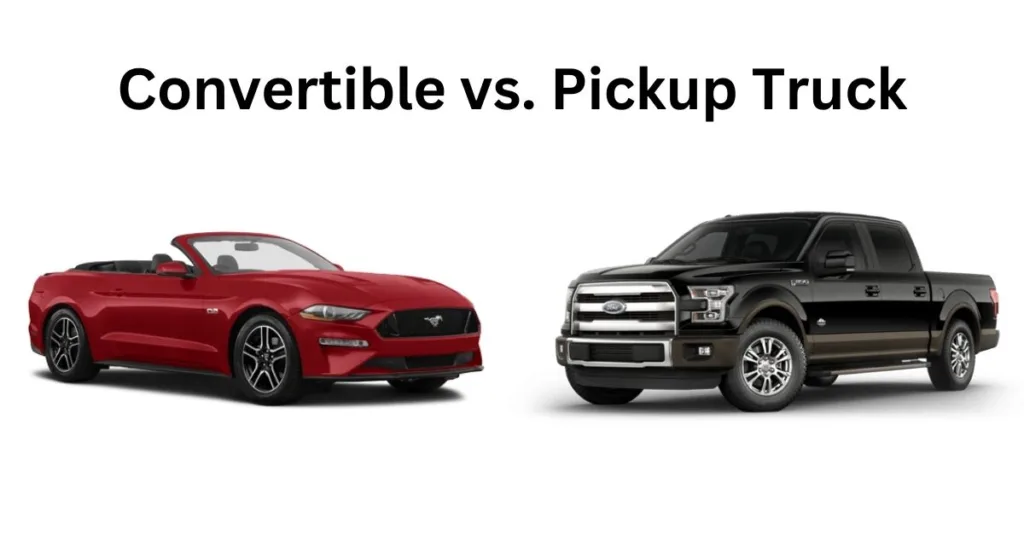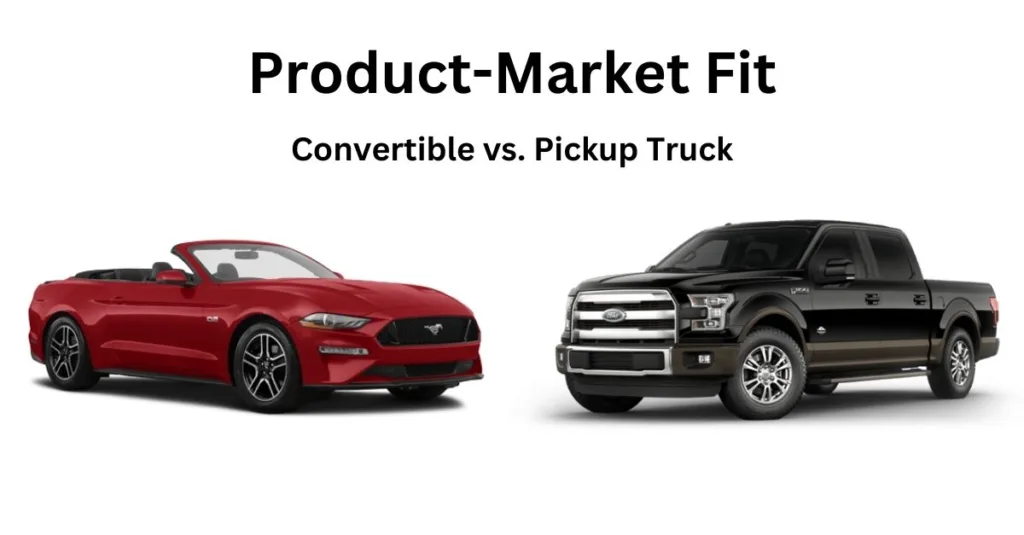Product-market fit, or product/market fit, is often mischaracterized and misunderstood even by “experts.” Contrary to popular belief, product/market fit is not a well-defined state that a product or startup has achieved or did not achieve.
Instead, product-market fit is the degree to which a product meets the needs of a particular set of users trying to perform specific tasks.
Pick-up Truck vs. Convertible Example
Let’s break down the above definition of product-market fit using a simple example that, hopefully, most of us can relate to: pickup truck vs. convertible.

Product-Task Fit
Let’s say that you have to haul a thousand pounds of bricks from a brick factory to a site across town. You could accomplish this task by putting a few dozen bricks into your hot red convertible and driving back and forth across town a bunch of times to move all of them.
Is the convertible a great fit for the task? Not really, although you could accomplish the task using your red convertible if you really wanted to or had no other options. Perhaps you could even fit more bricks in the small back seat and save yourself a few trips, not to mention the mess and damage the bricks could cause.
What if you had a large pick-up truck with a payload capacity of a thousand pounds at your disposal? Awesome! You could put all the bricks in the back of the truck and make one quick trip rather than driving back and forth across town all day with your convertible. What’s more, the bed of the truck is a lot more durable than the back seat or trunk of the convertible. The truck is a much, much better tool for the job!

Product-Market Fit vs. Product-Task Fit
If you were a construction worker, chances are that you often need to haul a lot of heavy, rough, messy stuff like bricks, bags of cement, wooden boards, air compressors, saws, etc.
On the other hand, if you are a retiree living in Southern California, chances are that you want to enjoy the sun while you drive back and forth from your favorite country club and restaurants. You probably don’t have to haul thousands of pounds of bricks very often.

If you are an outdoor enthusiast living in Colorado, you probably need a car that can handle snow and rough roads while being able to carry your skis, kayaks, and mountain bikes. A convertible might not be the best fit for your lifestyle, but a pickup truck might do the trick. But perhaps you are very environmentally conscious and don’t like how much gas a large pickup truck burns, so you opt for a more fuel efficient but still capable all-wheel drive crossover.

As the maker of sporty convertibles, you probably wouldn’t spend a lot of effort marketing to construction workers in the Pacific Northwest or outdoor enthusiasts in the Rocky Mountains. Your sporty convertible (product) probably doesn’t fit the needs of construction workers or Colorado sports enthusiasts (markets) very well.
From the above example, you can see that the degree to which your product (the sporty convertible) fits the various markets (construction workers in Alaska, outdoor enthusiasts in Colorado, or retirees in Southern California) differs across market segments and probably even among individual consumers.
Products Are Tools
In the above examples, we think of products as tools that help a customer accomplish different things. Clothes are tools to both keep you warm (or cool), express your individuality and character, make you look attractive or confident, etc.
Instagram is a tool that provides you with entertainment, a way to express your creativity, create a sense of self-worth, make your friends jealous of your travel, and allows you to stay in touch with friends.

A customer relationship management (CRM) platform is a tool that allows you to track sales leads, sales opportunities, conduct automated email campaigns to those leads, estimate quarterly sales revenue, etc.
A pickup truck is a great tool for hauling heavy, rough stuff. A convertible is great for enjoying the sun, but not the best tool for hauling heavy, rough payloads or your skis on a snowy Rocky Mountain road.
What you are building is a tool that allows your customers to accomplish a task or meet a need (hopefully more effectively than other alternatives). Product people, marketers, and business people often refer to these tools as “solutions.”
Markets are Groups of Customers or Users
Construction workers in the Southwest are a market, or group of customers for pickup trucks. Construction workers in the Rocky Mountains might be a different market for 4-wheel-drive pickup trucks specifically because they are more likely to encounter snowy conditions.
Retirees in Minnesota might have different needs and preferences than retirees in Southern California. Perhaps retirees in Minnesota favor convertibles with hard-tops and front-wheel drive to handle wintery conditions.
Outdoor enthusiasts in Colorado might have different needs than those in Silicon Valley, where gas prices are significantly higher and parking a bigger challenge. Perhaps those customers in San Francisco need a vehicle that can haul their outdoor gear, use little gas, and fit in tight urban parking spaces.

There might even be a group of customers, a “segment,” that often need to haul heavy equipment but are also outdoor enthusiasts. (There is a fair number of these folks in Utah, where I currently live.) These folks might strongly favor a pickup truck, which can adeptly meet all of their key needs–both hauling heavy, messy, rugged work equipment as well as their sports equipment such as mountain bikes and skis.
Product-Market Fit Is Measured on a Continuum
One thing that nearly everybody gets wrong is the notion that you either have product-market fit or you don’t. This is simply wrong.
Once again, it’s erroneous to say that a pickup truck doesn’t have product-market fit among Colorado outdoor enthusiasts, Silicon Valley techies, or retirees living in Southern California or even Florida. They clearly do for some. However, you could argue that a pick up truck has a greater degree of product-market fit with construction workers in Alaska than a sporty convertible. You could also argue that a pickup truck has a greater degree of product-market fit with construction workers in Alaska than retirees in Florida.
Product-market fit is not binary–you either have it or don’t.
Markets Can Be Cut into Tiny Segments
Customers or users can be grouped into arbitrarily sized segments or sub-groups and they can be grouped in any number of ways.
At our fund, Beta Boom, we also have customers or users: startup founders. We can think of our customers in many different ways, such as the following:
- Founders of companies
- Founders of high-growth companies (startups)
- Founders of tech startups
- U.S.-based founders of software startups
- U.S.-based founders of software startups who do not fit the typical Silicon Valley founder profile
- U.S.-based founders, who are tenacious underdogs not fitting the typical Silicon Valley founder stereotype, and are building pre-seed- and seed-stage software startups solving big, meaningful problems rather than fads or solving problems for the 1%
- U.S.-based founders, who are tenacious underdogs not fitting the typical Silicon Valley founder stereotype, and are building pre-seed- and seed-stage software startups solving big, meaningful problems rather than fads or solving problems for the 1% and really needing to understand what is meant by “product-market fit”
We can, and often do, get very detailed in terms of how we think about you, the founder. We can also get very specific about the product that we offer ranging from specific investments to tactical articles such as this one. We know that what Beta Boom puts out into the world will be a very poor fit for some (such as product-market fit experts in this case), but will hopefully be amazing fits for others (such as those founders thoroughly confused by other definitions of product-market fit but having a strong desire to finally understand this concept).
When thinking about product-market fit, it’s important to precisely define your market.
Markets Share Needs
One of the best ways to group customers into markets or segments is by their shared needs.
For example, folks that need to haul a lot of sports equipment as well as other heavy, messy, rugged stuff in wintery conditions can be thought of as one market–a market that would be a great fit for our four-wheel drive pickup truck. This market might include sports enthusiasts, construction workers, and retirees in Utah and Colorado.

An incredible resource that you should read, if you want to dive deeper, is the Jobs to Be Done book by Tony Ulwick, the often-cited inventor of this concept.
An Example of Product-Market Fit with JustinTV vs. Twitch
One of my favorite examples of product-market fit in a real startup context is the story of how JustinTV became Twitch.
Before there was Twitch, there was JustinTV. JustinTV was founded by Justin Kan, Michael Siebel, Emmett Shear, Kyle Vogt in 2007 as essentially a live 24/7 feed of Justin Kan’s life. Eventually, JustinTV grew to tens of thousands of broadcasting channels and had about 30 million monthly unique viewers at its height.

I now ask you, did JustinTV have product-market fit? That’s an impossible question because product-market fit is not binary; it’s measured on a continuum and in a particular context.
It turns out that even with millions of viewers and tens of thousands of live casters, JustinTV’s growth stalled.
However, Emmett Shear realized that users watching live streams of gamers were particularly active. This audience accounted for only 3% of JustinTV’s audience.
The founders decided to run an experiment and dedicate a small team to just supporting the gaming streamers and audience. It worked! Soon, usage and engagement took off like a rocket, and JustinTV chose to ignore the other 97% of their users to focus on live streaming gaming, rebranded to Twitch, and a $45 billion-dollar company within Amazon’s portfolio.
Clearly, Twitch (formerly known as JustinTV) had much stronger product-market fit with gamer streamers and their audiences.
The real issue is not defining product-market fit but knowing how much you have and if there are ways to get more.
And Now: A Clearer Definition of Product-Market Fit
Now, let’s bring everything together to create a (hopefully) clearer definition of product-market fit.
In the simplest normal-people terms, product-market fit is the degree to which a group or groups of people like your product.
A more formal definition might read like this: product-market fit is the degree to which a market or markets deems a particular product to meet their needs of performing specific tasks.
I find that sometimes, it’s useful to think about fit with the customer or user first, but one can also think about product-market fit with the product in the spotlight.
In this case, product-market fit is the degree to which a product meets the needs of a particular set of users trying to perform specific tasks.
The reality is that you can create whatever definition of product-market fit that makes sense to you.
Good luck, builders!

Get on our radar for an investment.
Beta Boom invests in founders who don’t fit the traditional Silicon Valley mold.

